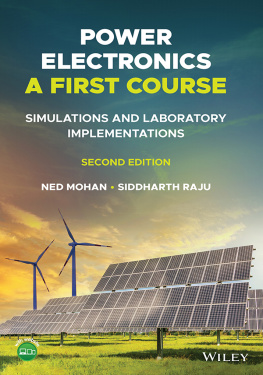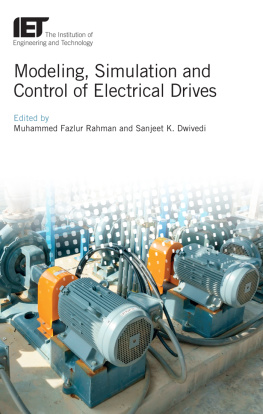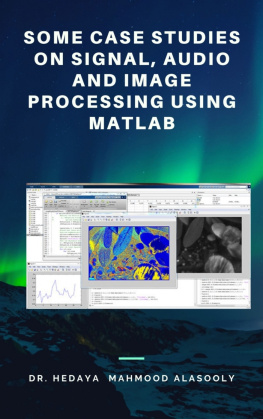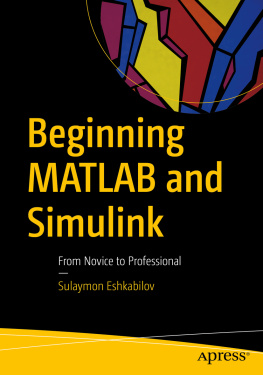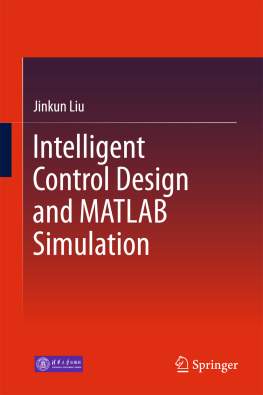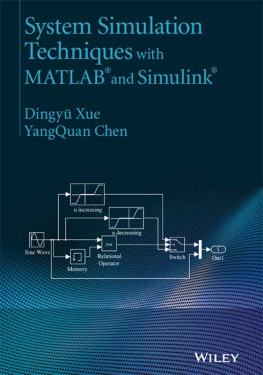Alassouli - Simulation of Some Power Electronics Case Studies in Matlab Simpowersystem Blockset
Here you can read online Alassouli - Simulation of Some Power Electronics Case Studies in Matlab Simpowersystem Blockset full text of the book (entire story) in english for free. Download pdf and epub, get meaning, cover and reviews about this ebook. year: 2017, genre: Romance novel. Description of the work, (preface) as well as reviews are available. Best literature library LitArk.com created for fans of good reading and offers a wide selection of genres:
Romance novel
Science fiction
Adventure
Detective
Science
History
Home and family
Prose
Art
Politics
Computer
Non-fiction
Religion
Business
Children
Humor
Choose a favorite category and find really read worthwhile books. Enjoy immersion in the world of imagination, feel the emotions of the characters or learn something new for yourself, make an fascinating discovery.

- Book:Simulation of Some Power Electronics Case Studies in Matlab Simpowersystem Blockset
- Author:
- Genre:
- Year:2017
- Rating:5 / 5
- Favourites:Add to favourites
- Your mark:
- 100
- 1
- 2
- 3
- 4
- 5
Simulation of Some Power Electronics Case Studies in Matlab Simpowersystem Blockset: summary, description and annotation
We offer to read an annotation, description, summary or preface (depends on what the author of the book "Simulation of Some Power Electronics Case Studies in Matlab Simpowersystem Blockset" wrote himself). If you haven't found the necessary information about the book — write in the comments, we will try to find it.
Alassouli: author's other books
Who wrote Simulation of Some Power Electronics Case Studies in Matlab Simpowersystem Blockset? Find out the surname, the name of the author of the book and a list of all author's works by series.
Simulation of Some Power Electronics Case Studies in Matlab Simpowersystem Blockset — read online for free the complete book (whole text) full work
Below is the text of the book, divided by pages. System saving the place of the last page read, allows you to conveniently read the book "Simulation of Some Power Electronics Case Studies in Matlab Simpowersystem Blockset" online for free, without having to search again every time where you left off. Put a bookmark, and you can go to the page where you finished reading at any time.
Font size:
Interval:
Bookmark:
By
Dr. Hidaia Mamood Alassouli
Matlab SimPowerSystems is a modern design tool that allows scientists and engineers to rapidly and easily build models that simulate power systems. Not only can you draw the circuit topology rapidly, but your analysis of the circuit can include interactions with mechanical, thermal, control, and other disciplines. The paper covers some case studies that provide detailed, realistic examples of how to use SimPowerSystems in power system analysis. The following types of studies are covered on the paper:
1. Thyristor-Based Static Var Compensator: Study the steady-state and dynamic performance of a static var compensator (SVC) on a transmission system.
2. Transient Stability of a Power System with SVC and PSS: Study of the application of static var compensator (SVC) and power system stabilizers (PSS) to improve transient stability and power oscillation damping of the system.
3. GTO-Based STATCOM: Study the steady-state and dynamic performance of a static synchronous compensator (STATCOM) on a transmission system.
4. Control of load flow using UPFC: Study the steady-state and dynamic performance of a unified power flow controller (UPFC).
5. Variable-frequency Induction Motor Drive: Study of a PWM inverter is used as a variable-voltage, variable-frequency source to drive an induction motor in variable-speed operation.
6. Chopper-Fed DC Motor Drive: Study of a DC motor drive with armature voltage controlled by a GTO thyristor chopper.
7. VSC-Based HVDC Link: Modeling of a forced-commutated voltage-sourced converter high-voltage direct current (VSC-HVDC) transmission link.
Index Terms --AC motor drives, DC motor drives, HVDC converters, Power system dynamic stability, Pulse width modulated power converters, Static VAR compensators, Thyristor converters.
Electrical power systems are combinations of electrical circuits and electromechanical devices like motors and generators devices and sophisticated control system concepts that tax traditional analysis tools and techniques. Further complicating the analyst's role is the fact that the system is often so nonlinear that the only way to understand it is through simulation. Land-based power generation from hydroelectric, steam, or other devices is not the only use of power systems. A common attribute of these systems is their use of power electronics and control systems to achieve their performance objectives. Matlab SimPowerSystems[1] is a modern design tool that allows scientists and engineers to rapidly and easily build models that simulate power systems. It uses the Simulink environment, allowing you to build a model using simple click and drag procedures. SimPowerSystems toolbox is an efficient tool for modeling and simulating power system with FACTS devices and power converters. SimPowerSystems also is an efficient tool for modeling the dynamics of power system including all types of machines and controllers, i.e. modeling synchronous machines with governor, exciter and AVR, power system stabilizer, asynchronous machines, High Voltage DC Links (HVDC), DC motors and various speed controllers for DC and AC drives using power electronics converters. Reference [3] is one of the best references in studying multimachine system dynamics and stability. Reference [4] includes analysis of the properties of semiconductor devices and their applications as controlled rectifiers, inverters, cycloconverters , choppers, HVDC and solid state control of DC and AC motor. Reference [2], [5] include an overview of the principles of work of most FACTS devices.
The paper covers some case studies that provide detailed, realistic examples of how to use SimPowerSystems in modeling power system dynamics in various types of application that use power electronics converters. The following case studies are simulated on the paper:
1- Thyristor-Based Static Var Compensator.
2. Transient Stability of a Power System with SVC and PSS.
3. GTO-Based STATCOM.
4. Control of load flow using UPFC.
5- Control of AC motor.
6- Control of DC motor.
7- VSC-Based HVDC Link.
The SVC system shown in Fig.1, consists of a 735 kV/16 kV, 333 MVA coupling transformer, one 109 Mvar TCR bank and three 94 Mvar TSC banks (TSC1 TSC2 TSC3) connected on the secondary side of the transformer.

Fig. 1. SPS Model of the 300 Mvar on a 735 kV Power System
Switching the TSCs in and out allows a discrete variation of the secondary reactive power from zero to 282 Mvar capacitive (at 16 kV) by steps of 94 Mvar, whereas phase control of the TCR allows a continuous variation from zero to 109 Mvar inductive. Taking into account the leakage reactance of the transformer (0.15 pu), the SVC equivalent susceptance seen from the primary side can be varied continuously from -1.04 pu/100 MVA (fully inductive) to +3.23 pu/100 Mvar (fully capacitive). The SVC Controller monitors the primary voltage and sends appropriate pulses to the 24 thyristors (6 thyristors per three-phase bank) to obtain the susceptance required by the voltage regulator. The SVC control system is shown in Fig. 2, consists of the following four main modules:

Fig. 2. SVC Controller
1) Measurement system measures the positive-sequence primary voltage. This system uses discrete Fourier computation technique to evaluate fundamental voltage over a one-cycle running average window. The voltage measurement unit is driven by a phase-locked loop (PLL) to take into account variations of system frequency.
2) Voltage regulator uses a PI regulator to regulate primary voltage at the reference voltage (1.0 pu specified in the SVC Controller block menu). A voltage droop is incorporated in the voltage regulation to obtain a V-I characteristic with a slope (0.01 pu/100 MVA in this case). Therefore, when the SVC operating point changes from fully capacitive (+300 Mvar) to fully inductive (-100 Mvar) the SVC voltage varies between 1-0.03=0.97 pu and 1+0.01=1.01 pu..
3) Distribution Unit uses the primary susceptance Bsvc computed by the voltage regulator to determine the TCR firing angle and the status (on/off) of the three TSC branches. The firing angle as a function of the TCR susceptance BTCR is implemented by a look-up table from the equation
(1)
where BTCR is the TCR susceptance in pu of rated TCR reactive power (109 Mvar).
4) Firing Unit consists of three independent subsystems, one for each phase (AB, BC and CA). Each subsystem consists of a PLL synchronized on line-to-line secondary voltage and a pulse generator for each of the TCR and TSC branches. The pulse generator uses the firing angle and the TSC status coming from the Distribution Unit to generate pulses. The firing of TSC branches can be synchronized (one pulse is sent at positive and negative thyristors at every cycle) or continuous.
The steady-state waveforms and the SVC dynamic response when the system voltage is varied is simulated in Fig. 3. Initially the source voltage is set at 1.004 pu, resulting in a 1.0 pu voltage at SVC terminals when the SVC is out of service. As the reference voltage Vref is set to 1.0 pu, the SVC is initially floating (zero current). This operating point is obtained with TSC1 in service and TCR almost at full conduction ( = 96 degrees).
Font size:
Interval:
Bookmark:
Similar books «Simulation of Some Power Electronics Case Studies in Matlab Simpowersystem Blockset»
Look at similar books to Simulation of Some Power Electronics Case Studies in Matlab Simpowersystem Blockset. We have selected literature similar in name and meaning in the hope of providing readers with more options to find new, interesting, not yet read works.
Discussion, reviews of the book Simulation of Some Power Electronics Case Studies in Matlab Simpowersystem Blockset and just readers' own opinions. Leave your comments, write what you think about the work, its meaning or the main characters. Specify what exactly you liked and what you didn't like, and why you think so.

